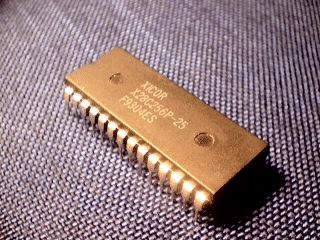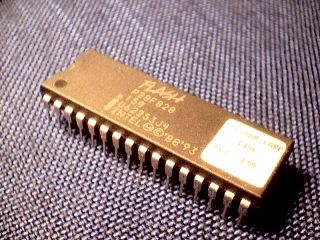|
|
|||||||
|
|
||||||||

|
||
|
|
Almost 100% of Eproms has its code starting by the manufacturer code, then 27xxxx. All (non OTP) eproms have a crystal window on top, it could be round, square or rectangular, but in all eproms you should be able to actually see the interior of the chip. All Eprom's body is made in ceramic or hard epoxy, crystal window eproms are NOT made in plastic as the other chips. OTP Eproms looks like the Eeprom picture below. OTP Eproms are exactly the same inside, the only difference is that they are built into a plastic (Epoxy) body and does not have the crystal window. The ceramic body is necessary to hold the crystal window. Without the erasing possibility, OTP devices are not recommended for home hobby programming. Some Eproms crystal window can be covered by a light protective paper sticker. The crystal window is necessary to ERASE the eprom, upon exposing the chip to a strong UV (ultra-violet) light. There are special devices for this purpose, called EPROM ERASER - they can be found for sale in several electronic stores, cost from $40 to $200. An EPROM can only be erased upon exposure to UV, no other way. Programming an eprom with any eprom programmer will only change bits from "1" to "0", while erasing under UV will return ALL bits to "1". Keep in mind that when purchasing an Eprom Programmer, or planning to deal with Eproms, it is 100% necessary to purchase an Eprom eraser, since you WILL need one very soon, to clean up old programmed eproms or to correct mistakes and programming errors. After a certain erase/write count, the eprom will fail to erase or fail to program. This count depends on several factors, as excessive time exposure to UV light, harsh operation conditions, etc. As experience, an Eprom can be erased or reprogrammed hundreds or thousands of times without any problem, but we also noticed some eproms that failed right after the first erasure, some others that fail right out of the factory package. OTP Eeproms should only be used in controlled environment, where the user will have great chances in not having programming errors. As a rule of thumb, OTP devices should never be considered for hobby projects or home programming, since a single programming failure is enough to ruin the whole device, without any chance to erase. Most novices in this area are tricked by one or two dollars in price difference from a real windowed eprom to an OTP unit, and later will find out that the cheap could end up being expensive. Considering an extreme case of 8 Megabits OTP eproms, a single bit programming error means one error by eight million chances, that is not rare to happens. It is not a problem for eraseable eproms, but for OTP chips it represents money loss. Buyers should exercise extreme care when purchasing eproms, since there is no way to ensure an eprom is good or not when purchasing used eproms. The seller usually will say the eprom was working, the buyer will think the problem is with the programmer. Due to the extreme different setups necessary at the programmer for some eproms, it is common the user conclude that the programming failure is related to the programmer itself, and not to the bad eprom. |
|
|
|
Almost 100% of Eeproms has its code starting by the manufacturer code, then 24xxx, 93xxx or 28xxx, packed into plastic body. Eeproms are also said and written as E2prom or Eeprom. There are two types of Eeproms, serial or parallel. Serial units uses less pins, since data comes in and out via fewer pins, so it is very common to find Serial Eeproms in 8 pins package, as the codes 93C08, 24C16 and so on. Parallel Eeproms use the full data byte pinout, and the addressing scheme is also parallel, so it uses the same pinout as the regular EPROMS, packages of 24, 28, 32 pins and so on, codes as 28C256 and others Eeproms are electric erasable, so it DOES NOT need the UV eraser. The erasing procedure is done by electric means, the Eprom programmer would be able to erase the device upon command, or during the reprogramming. Due to the kind of technology, Eeproms are not used any longer for larger memory sizes, they are widely substituted by Flash units, that are cheaper and stand much bigger cell count. Eeproms in general have a limited write/erase count life, this can vary from manufacturer to manufacturer, but it can goes from 100 thousand to one million writes per address, after that, the eprom will start to fail and should be replaced. Some devices using Eeproms were built with this in the mind of the designer, those devices were produced to stand several years of operation based on the daily many write sequences. This situation can be found in VCRs, Remote Controls, Computer Monitors, any other device where some kind of setup or preset could be programmed by the user. After some time those Eeproms will reach the failing write count and will not accept further programming or will program bad data, at this point they should be replaced. |
|
|
|
Almost 100% of Flash Units has its code starting by the manufacturer code, then 29xxx, packed into plastic body. One example is the AT29F040 or AM29F020. All the new digital cameras memory is based on flash devices, they can reach 128, 256, even 512 MegaBytes of data in a small slim compact flash card. Flash units usually can hold large cell count, it means large memory size. They can stand less programming (erase/write) count, sometimes around just ONE thousand cycles, after that, the Flash will fail. Most computer BIOS chips uses FLASH units, since they can be reprogrammable right on board, without needing to remove the chip and using an external programming unit. This feature turns very easy to update codes, software versions, etc. Most PCs motherboards manufacturers supply a small software that allows the user to update the FLASH BIOS with a new version without much trouble. Flash devices can be seen in several footprint, starting from 28, 32, 40 DIP package to large pinouts in PLCC, FlatPack or other pinout design. Some devices has 8, 16, or even 32 bit count in the data bus. Most EPROM programmers can deal only with 8 bits data bus, very few and expensive can deal with 16 or 32 bits. As Eeproms, flash units can be erased by electric means, the Eprom/Flash programmer device is usually able to erase the flash in a special command or during reprogramming. Purchasing used FLASH devices is risky, since you never know how many times the unit was already erased/write, so it can be very close to its end-of-life, or already reached that point. There are several FLASH units manufacturer, from AMD, Atmel, Catalystic and much others. |
|







